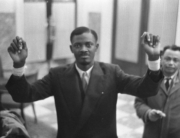
Anders Danielsen Lie as Anders (Strand Releasing)
Sophomore director Joachim Trier skillfully evokes the feeling of having an addict in one’s life. For most of this compelling film, the handsome but squirrelly Anders (Anders Danielsen Lie) wears his stress like a lanyard around his neck. He’s on leave from his stint at a rehab clinic for a job interview. Oslo, the city in which he partied for most of his young life, is still there to receive him. Trying to recapture at least something of what he left behind, he visits a close friend, persistently phones an ex-girlfriend, and eventually, by the end of the film’s mere 24-hour timeline, meets up with the old party crowd. It’s only by this point that Anders finally loosens up, giving the audience a much-needed reprieve. Sadly, this comes with all the potential, drug related pitfalls of a reckless nightlife.
The experience of Oslo, August 31st is not unlike the real thing. Seeing an addict go through a stressful day fighting to stay sober is a heart-wrenching ordeal, and often a relapse feels closer to stress-relief than anything else. Trier and Lie, who collaborated on 2006’s masterful Reprise, create a convincing and effective space in Oslo, one in which it’s hard not to believe each of Anders’s decisions as actually happening before our eyes.
Trier’s camera work isn’t formally rigid. Rather, he employs different styles. During several early scenes, namely a visit with the sympathetic Thomas (Hans Olav Brenner), Trier holds takes longer than usual, remaining on a single angle for an often uncomfortable length of time. Later, though, the film has more of a Dardennes feel to it, as we follow Anders into the evening. These careful decisions will provide a comprehensive emotional journey for the audience.
At the outset of Oslo, Anders is on a precipice. For the entirety of the story, his every action is loaded with potential catastrophe, so that when he inevitably attends the job interview, or questions a mutual friend over coffee about the status of his ex, the audience is in full suspense. What’s memorable about this film, which is a whole lot better than just a drug addiction downer, is that Trier and Lie elicit a huge amount of sympathy along with the suspense. August 31st may or may not end up being the day Anders breaks his sober streak, but Oslo is an enriching experience for that fact that most audiences will walk away knowing something more about going to battle with that disease each day.
For anyone with an addict in his or her life, the idea of culpability is a complicated one. When does the disease end and personal responsibility begin? Oslo takes us in minute detail through the gray area of drug addiction in an objective, observational way, and allows us a long meditation on how it affects people. Because Anders has lost the connections he once had, loneliness might be one of the most powerful emotions conveyed. It’s thrilling when he finally loosens up at the party and meets someone with whom he might start a new relationship, one untainted by years of drug abuse and the collateral damage that comes with it.
To call Oslo, August 31st a “sad” film would be to admit that life itself is sad. Trier makes it clear that this journey is unremarkable, that nothing about this day represents something out of the ordinary for a lot of people. If Anders wins the battle against drug addiction, great. There is somebody out there just like him. If he loses the battle, sadly, the same is true.






Leave A Comment